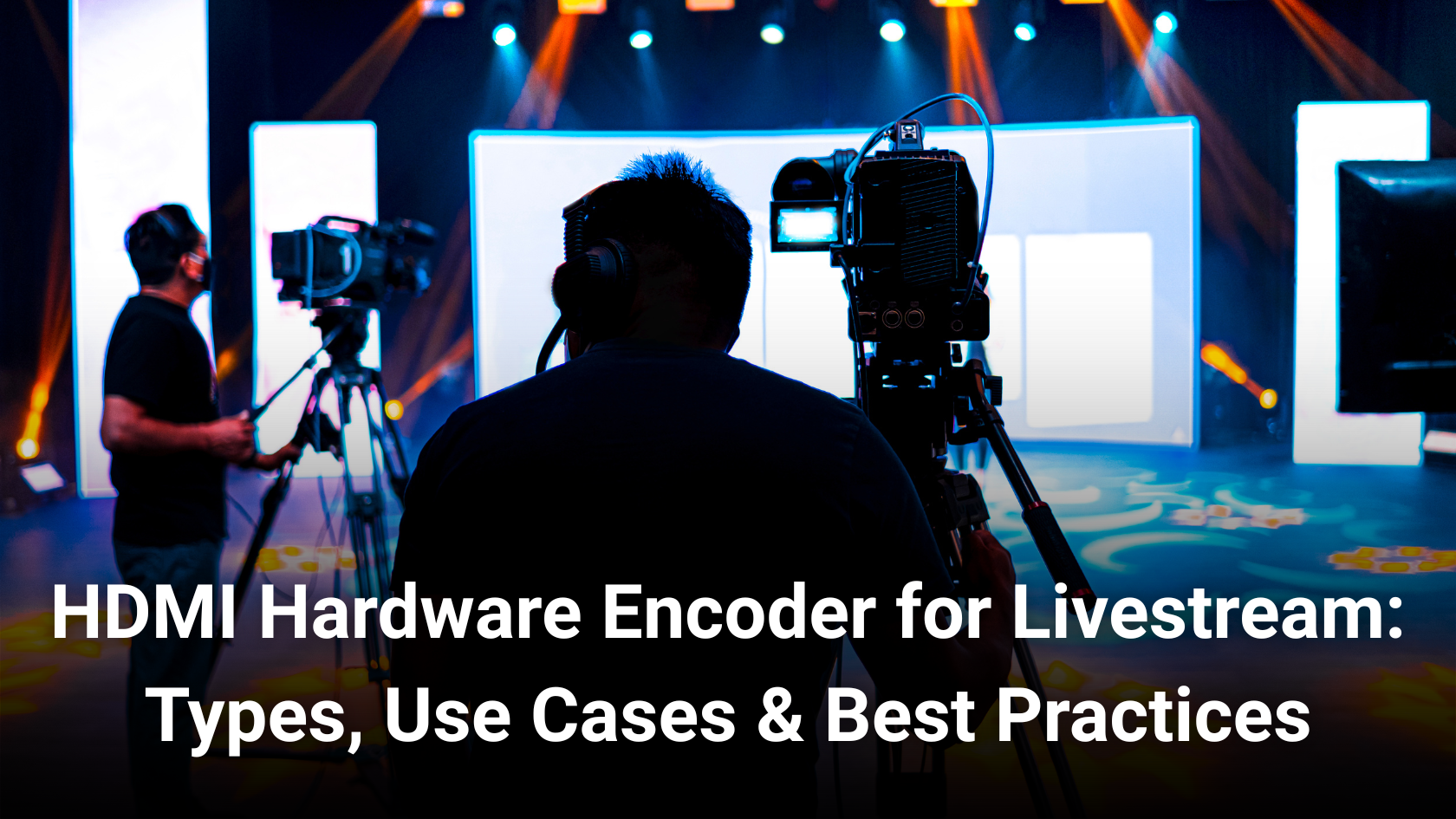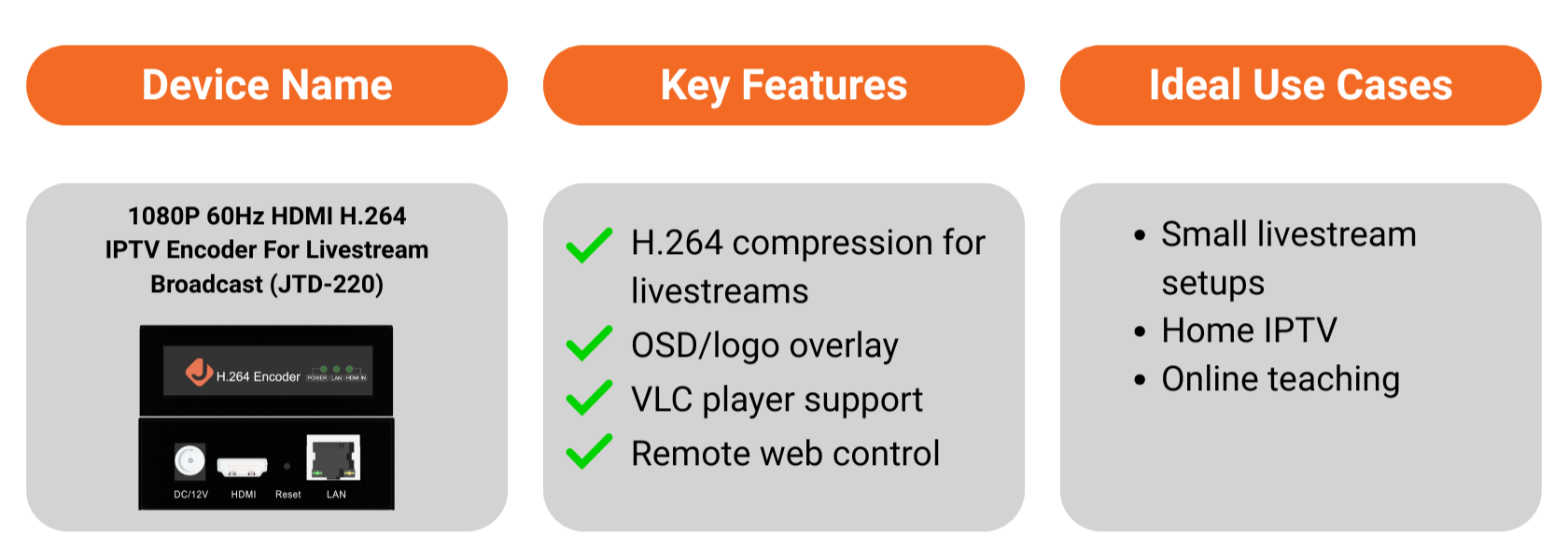HDMI Hardware Encoder for Livestream: Types, Use Cases & Best Practices
- Categories
- Articles
- Published
Explore HDMI hardware encoders for livestream: 1080p, 4K, multi-channel & IPTV devices. Learn key features, use cases, and how to choose the best one.

If you're planning to stream live events, lectures, gaming tournaments, or IPTV channels, you’ve probably run into the challenge of converting camera or HDMI sources into efficient, network-friendly video streams. That’s where an HDMI hardware encoder for livestream comes into play. In this post, we’ll explore the major types of HDMI hardware encoders, compare their features, and help you determine which one is best suited to your needs.
By understanding the differences; from single-channel 1080p encoders to 4K multi-channel / IPTV units, you’ll be able to choose the right encoder to optimize video quality, bandwidth efficiency, and reliability.
What Is an HDMI Hardware Encoder & Why Use One?
An HDMI hardware encoder is a device that takes a raw HDMI video (and often audio) signal and converts it (encodes it) into a compressed video stream (e.g. H.264, H.265) over IP networks (LAN / Internet). Unlike software encoding (e.g. OBS, vMix) which runs on a computer, hardware encoders handle that load in a dedicated box, reducing CPU usage, improving reliability, and reducing latency.
Benefits of hardware encoding include:
- Lower latency / more stable performance: Offloads encoding from general-purpose CPU
- Reliability & standalone operation: Can run 24/7 without depending on a full PC
- Protocol & format support: Many support RTMP, RTSP, NDI, HLS, ONVIF, etc.
- Scalability: Multi-channel encoding, simultaneous streams to multiple platforms
- Better consistency: Fixed hardware settings reduce variability across sessions
When choosing a hardware encoder, you’re not just choosing “one box," you're choosing what resolution, codecs, audio embedding, protocol support, and interfaces are most critical to your use case.
Types of HDMI Encoders: From 1080p to 4K, Multi-Channel & IPTV




Deep dive & examples:
- The single 1080p encoder is great when you have one camera or source, and your priority is simplicity and low bandwidth.
- The audio embedding model is especially helpful when your audio comes from a separate mixer. It lets you sync your video and audio at the encoder level.
- The 4K encoder with NDI offers flexibility for hybrid workflows and better future proofing. You can feed NDI into a production switcher or downstream system.
- The 8-port model is useful when scaling; e.g. in multi-camera setups, training environments, multiple classrooms, or broadcasting many channels at once.
When you choose, match your input count, output count (how many simultaneous streams), resolution needs, and future expandability.
Key Features & Specs to Evaluate
When comparing encoders (whether 1080p, 4K, or multi-channel), here are the top features to watch and how they map to practical needs.
1. Compression & Codec Support (H.264, H.265, MJPEG, NDI|HX2)
- H.264 is ubiquitous and widely compatible
- H.265 (HEVC) offers better compression (lower bandwidth) at similar quality, but device support is less universal
- MJPEG is less efficient but simpler, sometimes useful in surveillance or low-latency needs
- NDI or NDI|HX2 enables integration with IP networks and live production systems
2. Protocol Compatibility
- RTMP / RTMPS (for YouTube, Facebook, Twitch)
- RTSP / RTP (for IP cameras and local delivery)
- HLS / HTTP / FLV / SRT (for resilient streaming over variable networks)
- ONVIF (for integrating with security systems)
More protocols = more flexibility.
3. Audio Embedding & Inputs
- Many devices allow embedding of analog audio (e.g. from a mixer) into the HDMI stream
- Choose devices with audio line-in if your audio is external
- Also consider line-level and mic-level support
4. Input / Output Channel Count
- Single-channel for simple setups
- Multi-channel (4, 8, etc.) for more complex streams
- Loop-out or passthrough HDMI outputs let you monitor locally
5. Control / Configuration Options
- Web GUI / remote control
- On-device LCD / buttons
- Firmware updates (especially for security - e.g. RTMPS support)
6. Recording & USB Support
- Some encoders allow simultaneous recording (to USB or storage)
- Useful for archiving or post-production
7. Power, Form Factor & Cooling
- PoE (Power over Ethernet) support is a plus
- Fanless designs are quieter (good for studio / indoor use)
- Rack-mountable units for broadcast environments
8. Latency & Bandwidth Efficiency
- Lower latency is critical for live interaction
- Efficient compression helps minimize required bandwidth
By weighing these features in line with your requirements (how many sources, how much bandwidth, local vs remote, audio configuration), you can select an encoder that balances performance and cost.
Choosing the right HDMI hardware encoder for livestream is essential to achieving stable, high-quality broadcasts while minimizing bandwidth and complexity. Whether you need a simple 1080p single-channel model, an audio-embedding unit, a 4K/NDI box, or a multi-channel encoder, the key is matching features to your specific use case.
To recap:
- Hardware encoders offload processing, reduce latency, and increase reliability
- Evaluate by codec support, protocols, I/O count, control options, and audio embedding
- Use cases from single-camera streaming to IPTV networks drive your selection
- Troubleshooting and best practices help you maintain smooth operation
If you're ready to pick an encoder, compare your options via spec sheets, test sample units (if possible), reach out with your setup and we'll be happy to help you choose the right model or assist setting it up on your network.
You can find the products here. Just copy and paste the link:
1. 1080P 60Hz HDMI H.264 IPTV Encoder For Livestream Broadcast: https://www.jtechdigital.com/products/hdmi-encoder-1080p-60hz-h-264-iptv-encoder-for-livestream-broadcast
2. 1080P 60Hz HDMI H.264 Encoder Livestream with Audio Embedding: https://www.jtechdigital.com/products/hdmi-encoder-1080p-60hz-hdmi-h-264-livestream-encoder-with-audio-embedder
3. 4K 30Hz H.264 H.265 Livestream HDMI Encoder with NDI & PoE: https://www.jtechdigital.com/products/4k-30hz-h-264-h-265-livestream-hdmi-encoder-with-ndi-poe
4. 8 Port H.264, H.265, MJPEG HDMI Encoder for Livestream - 8 x 1080P 60Hz for YouTube Facebook Twitch VLC: https://www.jtechdigital.com/products/8-port-h-264-h-265-mjpeg-hdmi-livestream-encoder-8-x-1080p-60hz-for-youtube-facebook
Call our team at (888) 610-2818 or email us at sales@jtechdigital.com or support@jtechdigital.com for more information!

